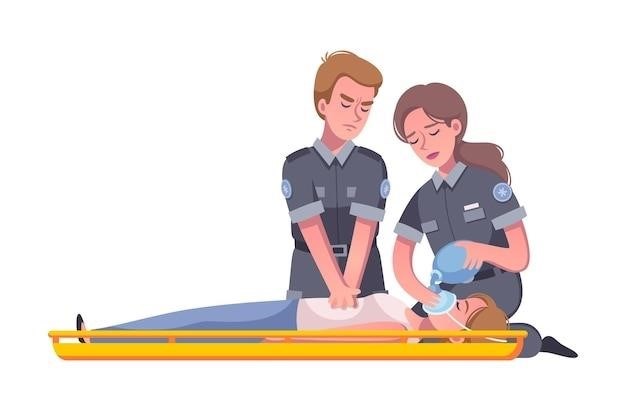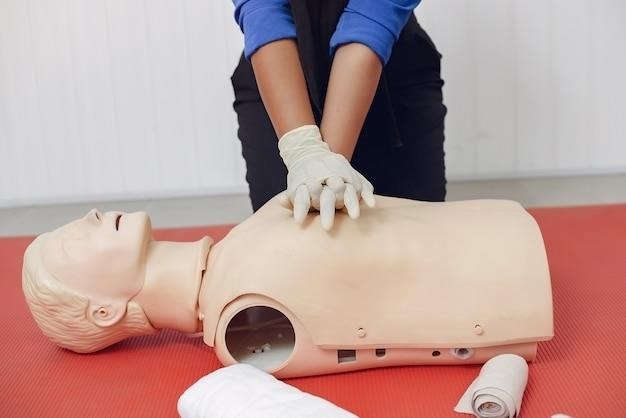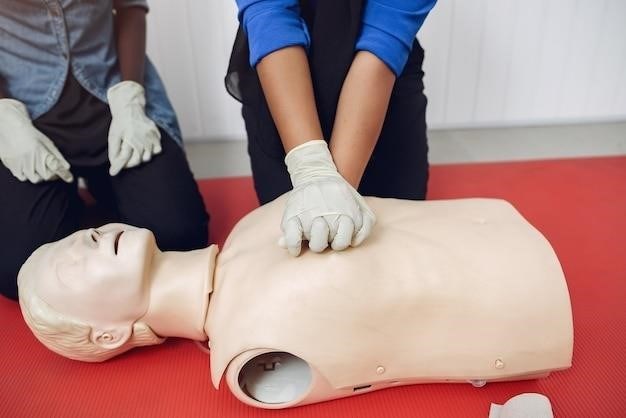Manual Resuscitator⁚ An Overview
Manual resuscitators, also known as bag-valve masks (BVMs), are handheld devices crucial for providing positive-pressure ventilation․ They deliver oxygen to patients experiencing respiratory distress or apnea․ BVMs are essential components of emergency medical kits, readily available for immediate use in critical situations․ Proper training is vital for effective and safe operation․
Types of Manual Resuscitators
Manual resuscitators, or bag-valve masks (BVMs), are categorized based on several factors, primarily the materials used in their construction and their intended patient size․ Silicone, PVC, and SEBS are common materials, each offering different properties in terms of durability, flexibility, and reusability․ Silicone, for example, is known for its biocompatibility and resistance to tearing, making it suitable for single-use applications․ PVC, a more cost-effective option, may be preferred for less demanding situations․ SEBS offers a balance of flexibility and durability․ The size of the resuscitator is also a key differentiator․ Adult, pediatric, and neonatal sizes are available to accommodate the varying needs of different age groups, ensuring an appropriate mask fit and effective ventilation․
Furthermore, some manual resuscitators incorporate advanced features such as integrated oxygen reservoirs or PEEP (positive end-expiratory pressure) valves․ These additions enhance oxygen delivery and improve the overall effectiveness of ventilation, especially in patients with compromised respiratory function․ The choice of resuscitator depends on several factors, including the patient’s age, clinical condition, and the availability of advanced features․ Appropriate selection is critical for successful ventilation and optimal patient care․
Materials Used in Manual Resuscitator Construction
The construction of manual resuscitators involves a careful selection of materials to ensure functionality, safety, and durability․ The self-inflating bag, the most prominent component, is typically made from flexible, non-toxic materials such as silicone, PVC (polyvinyl chloride), or SEBS (styrene-ethylene-butylene-styrene)․ Silicone is favored for its biocompatibility, resistance to tearing, and clarity, allowing for easy visual inspection of the bag’s contents․ PVC provides a more economical alternative, while SEBS offers a balance of flexibility and strength․ The choice of material often influences the reusability of the device; silicone bags are frequently designed for single use, while PVC or SEBS might allow for multiple uses under specific conditions and sterilization protocols․
Beyond the bag, other components require consideration․ The mask, often made from a soft, pliable material like PVC or silicone, must create a good seal around the patient’s face to prevent air leaks․ Valves, typically constructed from durable plastics and elastomers, control airflow, ensuring the unidirectional flow of air into and out of the patient’s lungs․ The connecting tubing and any additional features, such as oxygen inlets or PEEP valves, are also made from appropriate materials to withstand pressure and exposure to various gases․ The overall design prioritizes the use of materials that are both functional and safe for the patient, considering factors such as biocompatibility, sterility, and resistance to degradation․
Operation of a Manual Resuscitator
Operating a manual resuscitator requires a coordinated approach to ensure effective ventilation․ Begin by ensuring a patent airway; clear any obstructions, such as the tongue or foreign bodies, using appropriate techniques such as the head-tilt-chin-lift maneuver․ Select an appropriately sized mask for the patient to achieve a secure seal, covering both the nose and mouth․ Attach the mask firmly to the resuscitator bag, ensuring a leak-proof connection․ If supplemental oxygen is available, connect it to the designated port on the device․ Once the mask is in place, use the appropriate hand placement technique to maintain a tight seal against the patient’s face, minimizing air leakage․
Squeeze the bag with a controlled, consistent rhythm, providing adequate tidal volume and rate․ Observe the patient’s chest rise and fall with each compression to confirm effective ventilation․ Avoid overinflating the lungs, as this can lead to complications․ Monitor the patient’s response and adjust the ventilation rate and tidal volume as needed․ Regularly assess for adequate chest rise and fall, auscultate lung sounds, and monitor oxygen saturation levels if possible․ After use, dispose of the resuscitator appropriately according to established protocols, adhering to all relevant safety and infection control guidelines․ Remember, proper training is crucial for safe and effective operation of a manual resuscitator․

Bag Valve Mask (BVM) Ventilation
Bag-valve mask (BVM) ventilation, a crucial skill in emergency medicine, uses a self-inflating bag connected to a face mask to deliver breaths to patients unable to breathe adequately․ Proper technique is vital for effective oxygenation․
Proper Patient Positioning for BVM Ventilation
Optimal patient positioning is paramount for successful BVM ventilation․ The goal is to create a patent airway, ensuring the free flow of air․ This involves aligning the patient’s airway to maximize air exchange․ The “sniffing” position, achieved by slightly extending the neck and flexing the head, is often recommended․ This alignment brings the external auditory canal into line with the sternal notch, opening the airway․ However, this should be avoided in cases of suspected cervical spine injury․ In such instances, the jaw-thrust maneuver or chin lift should be employed to open the airway without neck movement․ For obese patients, additional padding under the shoulders might be necessary to achieve the correct sniffing position․ Similarly, infants and children might require padding behind their shoulders to account for their larger occiput․ Proper head and neck positioning is crucial for effective ventilation and should be adjusted based on the patient’s individual needs and any potential spinal injuries․ Remember to always prioritize patient safety and spinal stability when positioning for BVM ventilation․ The proper positioning ensures a clear airway, making ventilation more effective and minimizing the risk of complications․
Two-Person vs․ One-Person BVM Ventilation
While both one-person and two-person BVM ventilation techniques exist, the two-person approach is generally preferred and considered more effective for several key reasons․ With two individuals, one can focus solely on maintaining a secure mask seal against the patient’s face, while the other concentrates on squeezing the bag to deliver the ventilations․ This division of labor significantly enhances the efficiency and effectiveness of the procedure․ Maintaining a tight seal is crucial for preventing air leaks and ensuring that the delivered breaths reach the patient’s lungs․ A poorly sealed mask can lead to ineffective ventilation and compromise the resuscitation effort․ The two-person technique allows for a more consistent and controlled ventilation rate and volume, crucial for providing adequate oxygenation and preventing complications․ In contrast, the one-person technique requires the individual to manage both the mask seal and the bag squeezing, potentially leading to compromised ventilation and fatigue․ Although feasible in certain circumstances, the one-person method is often more challenging to perform effectively, particularly during prolonged resuscitation efforts․ Therefore, whenever possible, the two-person technique is recommended for optimal outcomes and patient safety․ The collaborative approach ensures better control, reduces operator fatigue, and ultimately improves the chances of successful resuscitation․
Troubleshooting Difficult BVM Ventilation
Difficulties encountered during bag-valve mask (BVM) ventilation often stem from inadequate mask seal, airway obstruction, or patient-related factors․ Addressing a poor mask seal involves checking for proper mask placement, ensuring a snug fit, and addressing any facial hair or deformities that might impede sealing․ Air leaks can be minimized by using appropriate mask sizes and applying gentle but firm pressure around the mask’s perimeter․ If the problem persists, consider using an alternative mask or airway adjunct․ Airway obstruction may result from the tongue, secretions, or foreign bodies․ Employing head-tilt-chin-lift or jaw-thrust maneuvers can help to alleviate tongue obstruction․ Suctioning the airway effectively removes secretions and foreign bodies․ If these simple maneuvers are ineffective, consider advanced airway management techniques․ Patient-related factors such as obesity, age extremes, or anatomical variations can significantly impact ventilation․ In obese patients, consider additional padding to achieve proper airway alignment․ For patients with limited jaw mobility or anatomical difficulties, alternative ventilation strategies may be necessary․ The mnemonic MOANS (Mask seal, Obesity/Obstruction, Age, No teeth, Snoring) helps to identify potential causes of difficult ventilation․ Addressing these factors systematically can improve ventilation success․ Always remember to assess the patient’s response to ventilation and adjust the technique as needed․ If challenges persist, seek assistance from other medical professionals․

Safety and Precautions
Always practice proper hygiene and utilize universal precautions (gloves, mask, eye protection)․ Dispose of the manual resuscitator appropriately after each use to prevent cross-contamination․ Understanding legal and ethical considerations regarding consent and limitations of use is paramount․
Discarding the Manual Resuscitator After Use
Proper disposal of a manual resuscitator after use is critical for infection control and public health․ Because manual resuscitators come into direct contact with patients’ airways, they become potential vectors for transmitting infectious agents․ Single-use devices should be discarded immediately following use, regardless of whether they appeared contaminated․ This is to prevent the spread of diseases such as influenza, tuberculosis, and other respiratory illnesses․ Discarding single-use devices according to local guidelines ensures that they are appropriately managed to minimize environmental harm and prevent the risk of accidental reuse․
For reusable manual resuscitators, a rigorous decontamination process is necessary after each use․ This usually involves cleaning with an appropriate disinfectant solution followed by thorough rinsing and drying․ Strict adherence to manufacturer’s instructions for cleaning and sterilization is essential; Properly cleaned and sterilized devices are then stored in a clean, dry place to prevent recontamination․ Regular inspection of reusable devices for signs of wear or damage is necessary․ Damaged or worn-out resuscitators must be replaced to ensure the safety and efficacy of ventilation․ Hospitals and healthcare facilities usually have specific protocols and guidelines for the disposal of medical waste, including single-use and reusable manual resuscitators․ These protocols should be followed diligently to maintain a safe and hygienic environment․
Legal and Ethical Considerations
The use of manual resuscitators raises several legal and ethical considerations, primarily revolving around informed consent, proper training, and adherence to established medical protocols․ Healthcare providers must ensure they possess the necessary training and skills to operate a manual resuscitator effectively and safely, avoiding negligence that could lead to patient harm․ In emergency situations where a patient is unable to provide consent, implied consent is generally accepted, but documentation of the situation and the reasons for intervention are crucial․ This detailed record helps protect the healthcare provider from legal repercussions․ Adherence to established resuscitation guidelines is imperative; deviations could lead to legal and ethical issues․
Furthermore, the use of a manual resuscitator should always be guided by the patient’s wishes, particularly in cases where advanced directives, such as a Do Not Resuscitate (DNR) order, exist․ Respecting patient autonomy and end-of-life decisions is paramount, and overriding these wishes could have serious ethical and legal consequences․ Maintenance of patient confidentiality is also important․ Any information regarding the patient’s condition or the use of the manual resuscitator should be handled according to relevant data privacy regulations․ Healthcare facilities must have clear protocols for the use of manual resuscitators, including training requirements, emergency procedures, and reporting mechanisms․ Compliance with these protocols helps minimize legal risks and ensures ethical practice․ Regular review and updates to these protocols are essential to incorporate best practices and address emerging issues․
